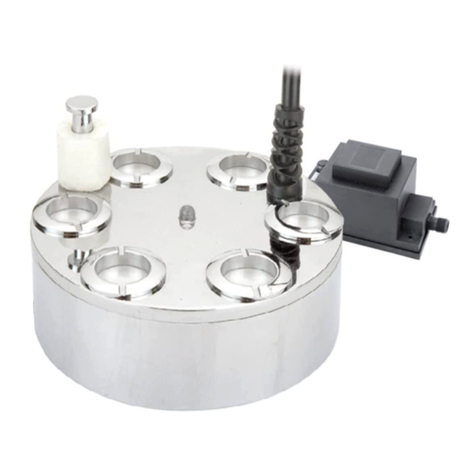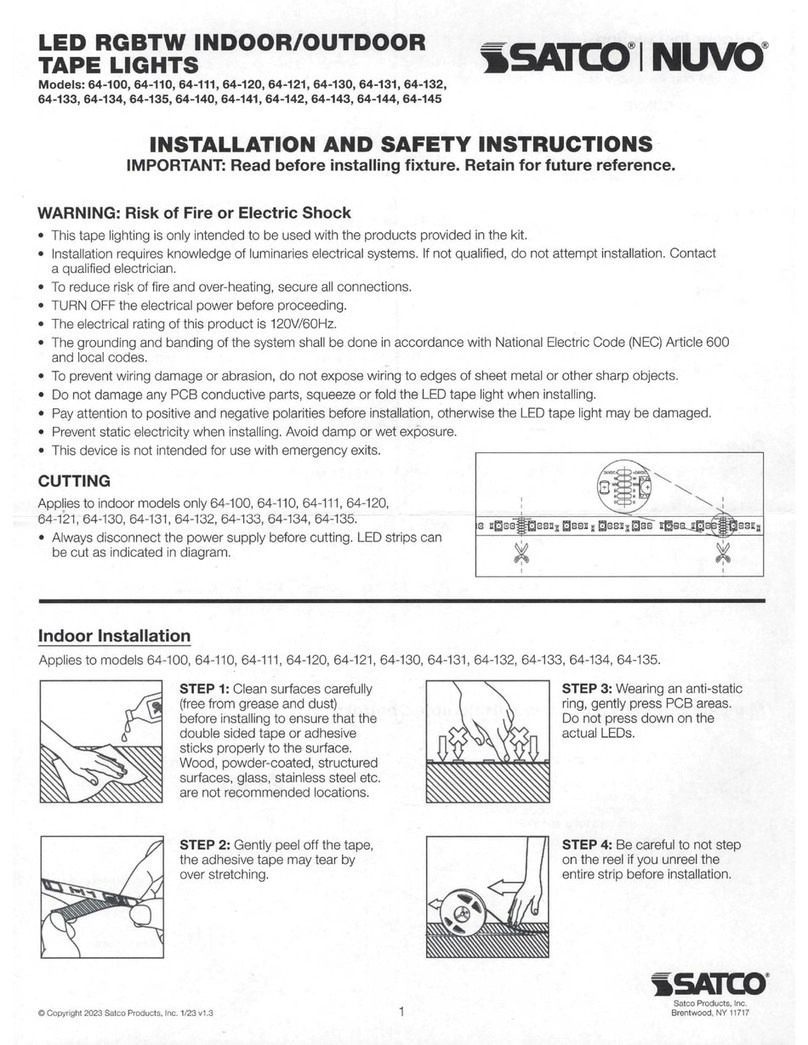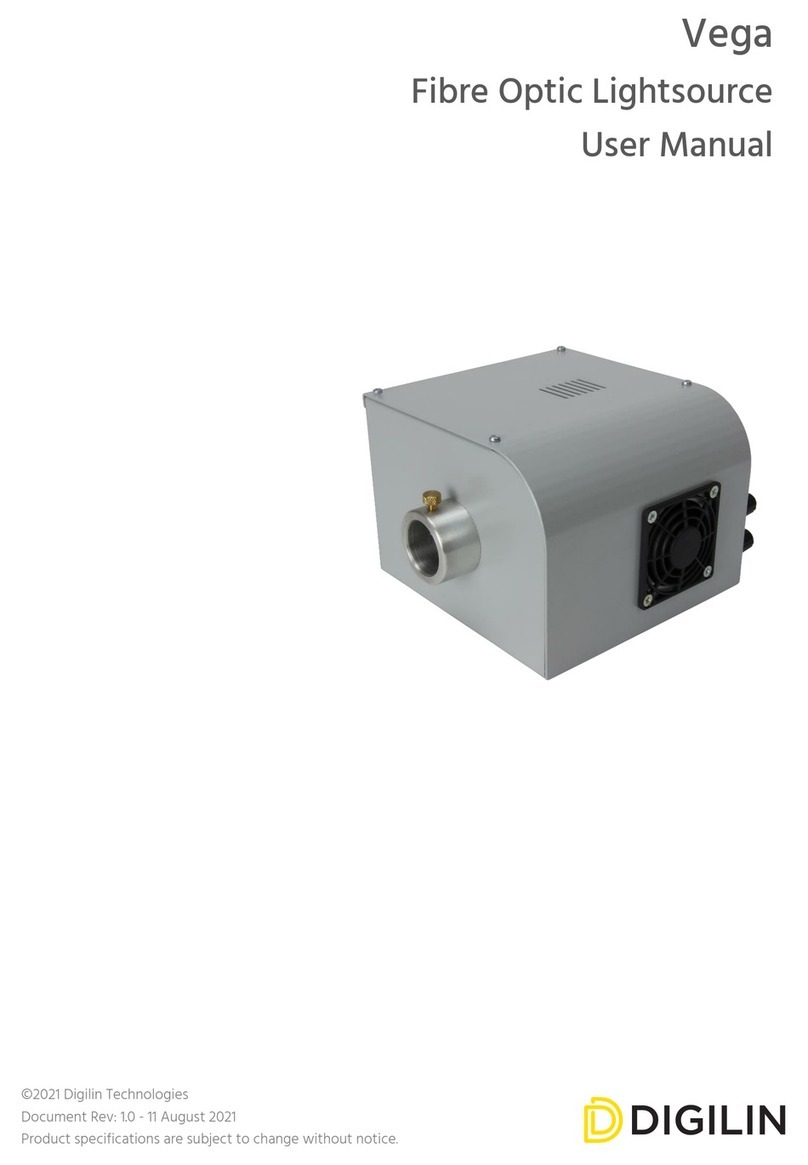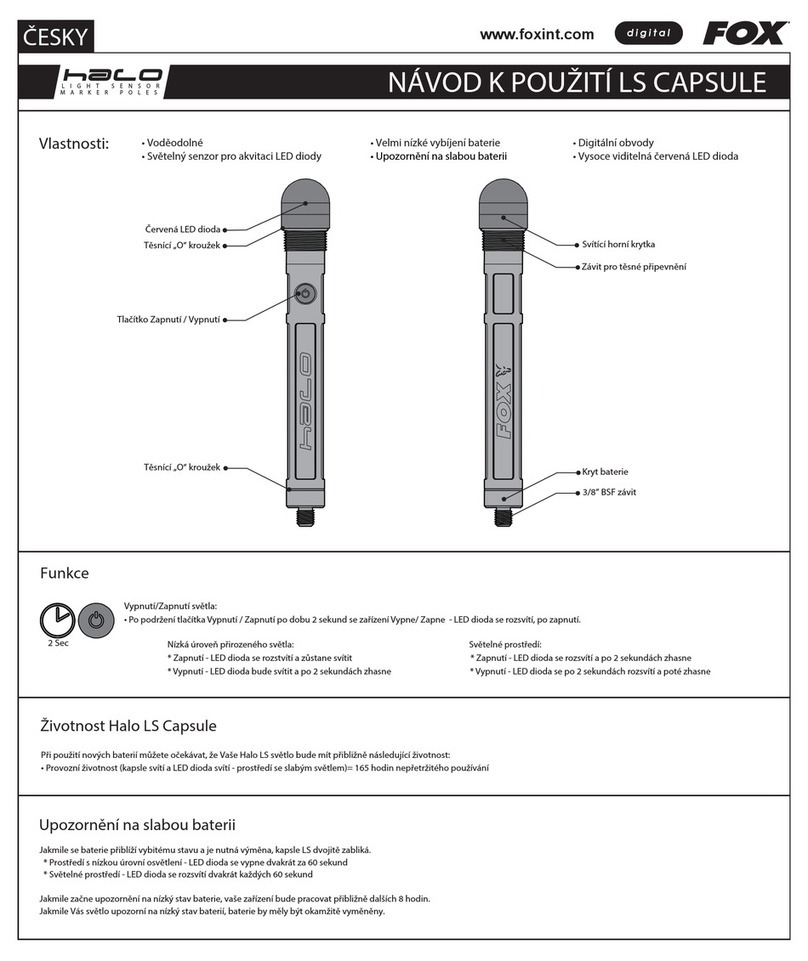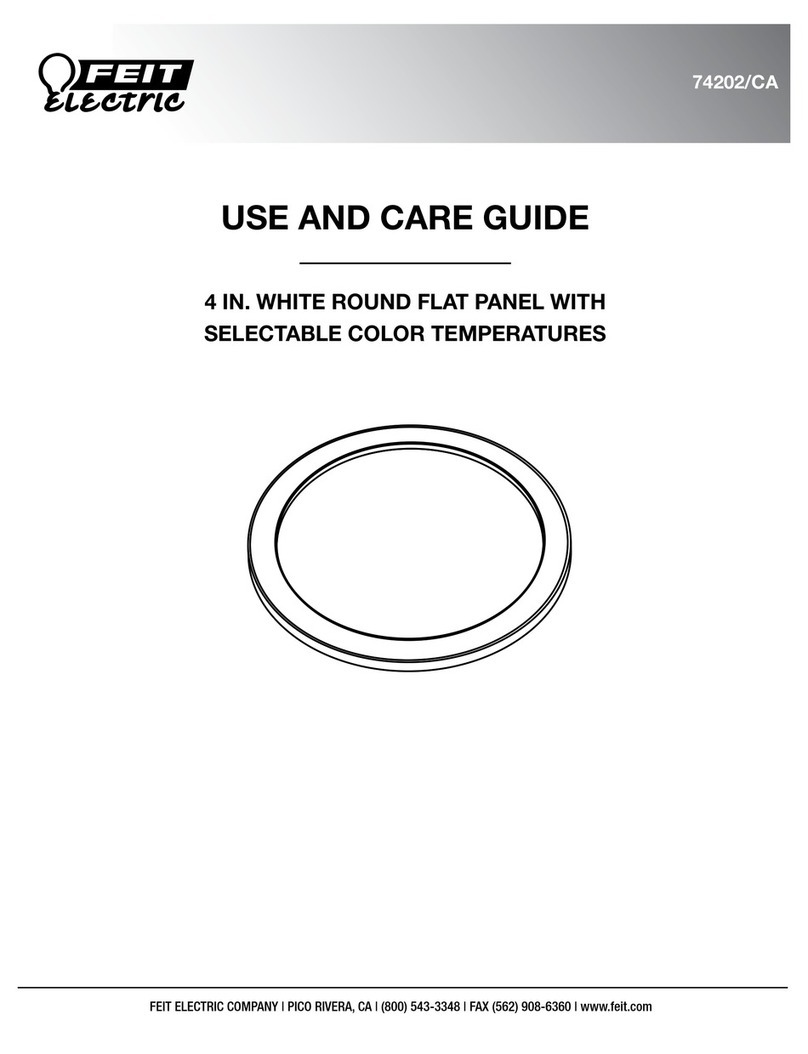Linear Technology DC2247A Quick setup guide

1
dc2247af
DEMO MANUAL DC2247A
Description
LT3922
36V 2A Synchronous
2MHz Boost LED Driver
Demonstration circuit DC2247A is a 36V 2A synchronous
2MHz boost LED driver featuring the LT
®
3922. It drives
a single string of LEDs at 330mA up to 34V when VIN is
between 7V and 28V. It runs down to 4VIN with reduced
ILED and can withstand VIN as high as 36V, but has over-
voltage lockout (OVLO) set for 28V for this application.
DC2247A runs at 2MHz switching frequency. Spread
spectrum frequency modulation (SSFM) can be turned
on with a simple jumper, reducing EMI. DC2247A comes
with low EMI features including optimized layout, SSFM,
and input and output filters. It passes CISPR 25 class 5
conducted and radiated EMI. It is protected against both
open and short LED conditions and reports the faults.
The LT3922 has an input voltage range from 2.8V to 36V.
Its internal synchronous 2A 40V switches allow up to 34V
of LEDs on the output with room for overvoltage protection
and overshoot during an open LED event. It has adjustable
switching frequency between 200kHz and 2.5MHz. It can
be synchronized to an external source or programmed with
SSFM for low EMI. The PWMTG high side PWM MOSFET
driver assists with short-circuit protection and versatility.
LT3922 can be configured as boost, boost-buck, or buck
mode LED driver and maintain all of its low-EMI, PWM
dimming and fault diagnostic features.
The LT3922 can be PWM dimmed with an external PWM
signal or an internally-generated PWM signal. DC2247A
has a jumper that can be set to switch between internally-
generated PWM signal, externally-generated PWM signal,
and no PWM signal (100% on). It can be analog dimmed
with a control voltage on its CTRL pin.
When run with both PWM dimming and SSFM, the spread
spectrum aligns itself with the PWM signal for flicker-free
operation.
L, LT, LTC, LTM, Linear Technology and the Linear logo are registered trademarks of Linear
Technology Corporation. All other trademarks are the property of their respective owners.
Small ceramic input and output capacitors are used to
save space and cost. The board is designed with tiny, high
frequency capacitors on both sides of the VOUT pins for
a reduction in radiated EMI. The open LED overvoltage
protection uses the IC’s constant voltage regulation loop
to regulate the output to approximately 37.5V if the LED
string is opened although it may reach almost 40V peak
during transient from running LEDs to open. There is a
protection diode from LED+to GND to prevent negative
ringing during a short circuit. The output current can be
monitored through the ISMON output pin.
Undervoltage and overvoltage lockout can be adjusted on
the circuit with a few simple resistor choices.
There is an EMI filter on the input of DC2247A. There is also
a small ferrite bead output filter. These filters, combined
with proper board layout and SSFM are effective to help
the PCB pass CISPR 25 class 5 conducted and radiated
EMI. Please follow the recommended layout and four-layer
thickness of DC2247A for low EMI applications.
The LT3922 data sheet gives a complete description of
the part, operation and applications information. The
data sheet must be read in conjunction with this Demo
Manual for DC2247A. The LT3922EUFD is assembled in a
28-lead plastic 4mm x 5mm QFN package with a thermally
enhanced ground pad. Proper board layout is essential
for maximum thermal performance. See the data sheet
section Layout Considerations.
Design files for this circuit board are available at
http://www.linear.com/demo/DC2247A

2
dc2247af
DEMO MANUAL DC2247A
Quick start proceDure
Demonstration circuit DC2247A is easyto set upto evaluate
theperformanceof the LT3922Follow theprocedurebelow:
1. With power off, connect a string of LEDs that will run
with forward voltage less than or equal to 34V(at
330mA) to the LED+and LED–terminals on the PCB
as shown in Figure 1.
2. Connect the EN/UVLO terminal to GND.
3. Set JP1 to ON and JP2 to EXT/ON for 100% always-on
LED operation. Set JP3 to NO SSFM to run without
SSFM or external synchronization.
4. With power off, connect the input power supply to the
LOW EMI VIN and GND terminals. Make sure that the
input voltage will not exceed 36V.
5. Turn the input power supply on and make sure the
voltage is between 5V and 36V to start operation.
6. Release the EN/UVLO-to-GND connection.
7. Observe the LED string running at the programmed
LED current.
8. To change the brightness with analog dimming, simply
attach a voltage source to the CTRL terminal and set
the voltage between 0V and 1.5V. See data sheet for
details.
9. To change brightness with external PWM dimming, set
JP1 to EXT and JP2 to EXT/ON. Attach a 3V rectangular
waveform with varying duty cycle to the PWM terminal.
10. To change brightness with internally-generated PWM
dimming, set JP1 to INT and JP2 to INT. Adjust the
setting of the VR1 variable resistor with a small flat-
head screwdriver to toggle between 0% and 100%
PWM dimming duty cycle in 1/128 steps.
11. To enable spread spectrum frequency modulation, set
JP3 to SSFM ON.
performance summary
Specifications are at TA= 25°C
PARAMETER CONDITIONS MIN TYP MAX UNITS
Input Voltage Low EMI VIN Range Operating ILED > 0mA 4 28 V
Input Voltage Low EMI VIN Range Operating VLED = 34V, ILED = 330mA 7 28 V
Safe Input Voltage Low EMI VIN Range 0 36 V
Switching Frequency R2 = 45.3k, SSFM = OFF 2 MHz
Switching Frequency R2 = 45.3k, SSFM = ON 2 to 2.5 MHz
ILED R1 = 0.3Ω, 7.0V < Low EMI VIN < 28V, VLED = 34V 330 mA
VLED Range R4 = 1M, R5 = 33.2k VIN 34 V
Open LED Voltage VOUT R4 = 1M, R5 = 33.2k, OPEN LOAD 37.5 V
Efficiency (100% PWM DC) PVIN = 12V, VLED = 34V, ILED = 330mA 90 %
Efficiency with EMI Filters Removed PVIN = 12V, VLED = 34V, ILED = 330mA 91 %
Internally-Generated PWM Dimming Range Operating JP1 = INT, JP2 = INT 1/128 100%
Internally-Generated PWM Dimming Frequency Operating JP1 = INT, JP2 = INT R10 = 332k 122 Hz

3
dc2247af
DEMO MANUAL DC2247A
Figure 1. Test Procedure Setup Drawing for DC2247A
Quick start proceDure
DC2247 F01
MONITOR
FAULT FLAG
MONITOR
LED CURRENT
–
+
–
+
VIN
+
–
VOUT
IIN
INPUT
SUPPLY
+–
ILED
–
+
UP TO
34V LEDS SET JP3 FOR SYNC AND SSFM.
CONNECT EXTERNAL SYNC
SIGNAL TO SYNC TERMINAL WHEN
“EXT SYNC” OPTION IS SELECTED.
SET JP1 AND JP2 TO MATCH
EXT: EXTERNAL PWM DIMMING
INT: INTERNAL PWM DIMMING
ON: 100% ON, NO PWM DIMMING
ADJUST VR1 WITH SCREWDRIVER
FOR INTERNAL PWM DIMMING
DUTY CYCLE CONTROL
1V 2V
OR
EXTERNAL
PWM DIMMING
OPTIONAL
SYNC
INTERNAL
PWM DIMMING
0V 2V
OPTIONAL
ANALOG DIMMING
FOR LED CURRENT
REDUCTION
OPTIONAL
CONNECT
EN/UVLO TO GND
FOR SHUTDOWN

4
dc2247af
DEMO MANUAL DC2247A
Quick start proceDure
Figure 2. DC2247A Efficiency and LED Current Versus Input Voltage for 34V 330mA LED Load. Efficiency Remains High
Through the Range Due to Synchronous Switching. At Low VIN, ILED Can Be Reduced Due to Peak Switch Current Limit
Figure 3. Infinite-Persist Scope Traces Show PWM Dimming and SSFM Working Together for Flicker-Free
Brightness Control with both a) Externally and b) Internally Generated PWM Dimming
a) b)
VIN (V)
EFFICIENCY (%)
DC2247 F02a
60
65
70
75
80
85
90
95
100
0
30
252015105
WITHOUT EMI FILTERS
WITH EMI FILTER
VIN (V)
LED CURRENT
DC2247 F02b
0.00
0.05
0.10
0.15
0.20
0.30
0.35
0.40
0
30
252015105
1µs/DIV
ILED
200mA/DIV
IL
1A/DIV
VIN = 12V, VLED = 34V, ILED = 330mA
fSW = 2MHz, SSFM ON
2000:1, 120Hz EXTERNAL PWM DIMMING
DC2247 F03a 10µs/DIV
ILED
200mA/DIV
IL
1A/DIV
VIN = 12V, VLED = 34V, ILED = 330mA
fSW = 2MHz, SSFM ON
128:1, 122Hz INTERNAL PWM DIMMING
V
PWM
= 1.01V
DC2247 F03b

5
dc2247af
DEMO MANUAL DC2247A
Quick start proceDure
Figure 4. DC2247A Conducted Peak and Average EMI—Passes CISPR 25 Class 5 Limits.
Figure 5. DC2247A Radiated Peak and Average EMI—30MHz to 1GHz—Passes CISPR 25 Class 5 Limits
MHz
PEAK CONDUCTED EMI (dBµV)
DC2247 F04a
–10
0
10
20
30
50
40
60
80
70
0.1 10 1001
CISPR 25
CLASS 5 LIMITS
CISPR 25 CLASS 5 LIMITS
NOISE FLOOR
MHz
PEAK RADIATED EMI (dBµV/m)
DC2247 F05a
–10
0
10
20
30
40
50
0
1000
800600400200
CISPR 25 CLASS 5 LIMITS
NOISE FLOOR
MHz
AVERAGE CONDUCTED EMI (dBµV)
DC2247 F04b
–10
0
10
20
30
50
40
60
80
70
0.1 10 1001
CISPR 25
CLASS 5 LIMITS
CISPR 25 CLASS 5 LIMITS
NOISE FLOOR
MHz
AVERAGE RADIATED EMI (dBµV/m)
DC2247 F05b
–20
0
10
20
30
–10
40
0
1000
800600400200
CISPR 25 CLASS 5 LIMITS
NOISE FLOOR
Figure 6. DC2247A Radiated Peak and Average EMI—150kHz to 30MHz—Passes CISPR 25 Class 5 Limits
MHz
PEAK RADIATED EMI (dBµV/m)
DC2247 F06a
10
15
20
25
30
40
35
45
50
0.1 101
CISPR 25 CLASS 5 LIMITS
NOISE FLOOR
MHz
AVERAGE RADIATED EMI (dBµV/m)
DC2247 F06b
0
5
10
20
15
25
30
35
40
0.1 101
CISPR 25 CLASS 5 LIMITS
NOISE FLOOR

6
dc2247af
DEMO MANUAL DC2247A
parts List
ITEM QTY REFERENCE PART DESCRIPTION MANUFACTURER/PART NUMBER
Required Circuit Components
1 1 C1 CAP., X5R, 4.7µF, 50V, 10%, 1206 MURATA, GRM31CR71H475KA12L
2 1 C2 CAP., X5R, 1µF, 50V, 10%, 0603 TDK, C1608X5R1H105K080AB
3 1 C3 CAP., X7R, 2.2µF, 50V, 10%, 1206 MURATA, GRM31CR71H225KA88K
4 2 C4, C5 CAP., X5R, 0.47µF, 50V, 10%, 0402 TAIYO YUDEN, UMK105ABJ474KV-F
5 1 C6 CAP., X7R, 220pF, 50V, 10%, 0603 MURATA, GRM188R71H221KA01D
6 1 C7 CAP., X7R, 2.2µF, 6.3V 10%, 0603 AVX, 06036C225KAT2A
7 1 C8 CAP., X5R, 1µF, 6.3V, 10%, 0402 MURATA, GRM155R60J105KE19D
8 2 C9, C10 CAP., X7R, 100nF, 6.3V, 10%, 0402 AVX, 04026C104KAT2A
21 1 L1 INDUCTOR, 4.7µH, 4.45mm x 4.06mm WURTH ELEKTRONIK, 74437324047
22 1 M1 P-MOSFET, Si2319CDS, SOT23 VISHAY, SI2319CDS-T1-GE3
23 1 R1 RES, CHIP, 0.3, 1/3W, 1%, 0805 SUSUMU, RL1220S-R30-F
24 1 R2 RES, CHIP, 45.3k, 1/16W, 1%, 0402 VISHAY, CRCW040245K3FKED
25 1 R3 RES, CHIP, 24k, 1/10W, 1%, 0603 VISHAY, CRCW060324K0FKEA
26 1 R4 RES, CHIP, 1M, 1/10W, 1%, 0603 VISHAY, CRCW06031M00FKEA
27 1 R5 RES, CHIP, 33.2k, 1/10W, 1%, 0603 VISHAY, CRCW060333K2FKEA
28 1 R6 RES, CHIP, 499k, 1/16W, 1%, 0402 VISHAY, CRCW0402499KFKED
29 1 R7 RES, CHIP, 221k, 1/16W, 1%, 0402 VISHAY, CRCW0402221KFKED
30 1 R8 RES, CHIP, 31.6k, 1/16W, 1%, 0402 VISHAY, CRCW040231K6FKED
31 1 R9 RES, CHIP, 100k, 1/16W, 1%, 0402 VISHAY, CRCW0402100KFKED
32 1 R10 RES, CHIP, 332k, 1/16W, 1%, 0402 VISHAY, CRCW0402332KFKED
36 1 U1 I.C., LED DRIVER, 28QFN 4X5 LINEAR TECH., LT3922EUFD#PBF
Optional Demo Board Circuit Components
9 1 C11 CAP., ALUM., 33µF, 50V, 20%, 6.3mm x 7.7mm SUN ELECTRONIC INDUSTRIES CORPORATION, 50CE33BS
10 2 C12, C13 CAP., X7R, 0.1µF, 50V, 10%, 0402 MURATA, GRM155R71H104KE14D
11 1 C14 CAP., X5R, 2.2µF, 6.3V, 10%, 0402 MURATA, GRM155R60J225ME15D
12 0 C15, C17, C18 (OPT) CAP., OPTION, 0603
13 0 C16, C19 (OPT) CAP., OPTION, 0402
14 1 D1 DIODE, SCHOTTKY, 40V, 1A, SOD323F NXP, PMEG4010CEJ, 115
17 1 FB1 CHIP, BEAD, 600Ω, 0805 WURTH ELEKTRONIK, 742792040
18 1 FB2 CHIP, BEAD, 1.5k, 0805 WURTH ELEKTRONIK, 742792097
33 1 R11 RES, CHIP, 91k, 1/10W, 5%, 0603 VISHAY, CRCW060391K0JNEA
34 1 R12 RES, CHIP, 51k, 1/10W, 1%, 0603 VISHAY, CRCW060351K0FKEA
35 0 R13, R14 (OPT) RES, OPTION, 0402
37 1 VR1 TRIMMER., 100k, 0.25W, SMD BOURNS, 3314J-1-104E
Hardware: For Demo Board Only
15 6 E1, E3, E8, E11-E13 TEST POINT, TURRET, 0.094" MTG. HOLE MILL-MAX, 2501-2-00-80-00-00-07-0
16 7 E2, E4-E7, E9, E10 TEST POINT, TURRET, 0.061" MTG. HOLE MILL-MAX, 2308-2-00-80-00-00-07-0
19 2 JP1, JP3 HEADER 3 PIN 0.079 DOUBLE ROW WURTH ELEKTRONIK, 62000621121
20 1 JP2 HEADER 3 PIN 0.079 SINGLE ROW WURTH ELEKTRONIK, 62000311121
38 3 XJP1, XJP2, XJP3 SHUNT, 0.079" CENTER WURTH ELEKTRONIK, 60800213421

7
dc2247af
DEMO MANUAL DC2247A
Information furnished by Linear Technology Corporation is believed to be accurate and reliable.
However, no responsibility is assumed for its use. Linear Technology Corporation makes no representa-
tion that the interconnection of its circuits as described herein will not infringe on existing patent rights.
schematic Diagram

8
dc2247af
DEMO MANUAL DC2247A
Linear Technology Corporation
1630 McCarthy Blvd., Milpitas, CA 95035-7417
(408) 432-1900 ●FAX: (408) 434-0507 ●www.linear.com
© LINEAR TECHNOLOGY CORPORATION 2016
LT 0816 • PRINTED IN USA
DEMONSTRATION BOARD IMPORTANT NOTICE
Linear Technology Corporation (LTC) provides the enclosed product(s) under the following AS IS conditions:
This demonstration board (DEMO BOARD) kit being sold or provided by Linear Technology is intended for use for ENGINEERING DEVELOPMENT
OR EVALUATION PURPOSES ONLY and is not provided by LTC for commercial use. As such, the DEMO BOARD herein may not be complete
in terms of required design-, marketing-, and/or manufacturing-related protective considerations, including but not limited to product safety
measures typically found in finished commercial goods. As a prototype, this product does not fall within the scope of the European Union
directive on electromagnetic compatibility and therefore may or may not meet the technical requirements of the directive, or other regulations.
If this evaluation kit does not meet the specifications recited in the DEMO BOARD manual the kit may be returned within 30 days from the date
of delivery for a full refund. THE FOREGOING WARRANTY IS THE EXCLUSIVE WARRANTY MADE BY THE SELLER TO BUYER AND IS IN LIEU
OF ALL OTHER WARRANTIES, EXPRESSED, IMPLIED, OR STATUTORY, INCLUDING ANY WARRANTY OF MERCHANTABILITY OR FITNESS
FOR ANY PARTICULAR PURPOSE. EXCEPT TO THE EXTENT OF THIS INDEMNITY, NEITHER PARTY SHALL BE LIABLE TO THE OTHER FOR
ANY INDIRECT, SPECIAL, INCIDENTAL, OR CONSEQUENTIAL DAMAGES.
The user assumes all responsibility and liability for proper and safe handling of the goods. Further, the user releases LTC from all claims
arising from the handling or use of the goods. Due to the open construction of the product, it is the user’s responsibility to take any and all
appropriate precautions with regard to electrostatic discharge. Also be aware that the products herein may not be regulatory compliant or
agency certified (FCC, UL, CE, etc.).
No License is granted under any patent right or other intellectual property whatsoever. LTC assumes no liability for applications assistance,
customer product design, software performance, or infringement of patents or any other intellectual property rights of any kind.
LTC currently services a variety of customers for products around the world, and therefore this transaction is not exclusive.
Please read the DEMO BOARD manual prior to handling the product. Persons handling this product must have electronics training and
observe good laboratory practice standards. Common sense is encouraged.
This notice contains important safety information about temperatures and voltages. For further safety concerns, please contact a LTC application
engineer.
Mailing Address:
Linear Technology
1630 McCarthy Blvd.
Milpitas, CA 95035
Copyright © 2004, Linear Technology Corporation
Table of contents
Popular Lighting Equipment manuals by other brands

Precision Lighting
Precision Lighting Domino Basis Track Series instruction manual
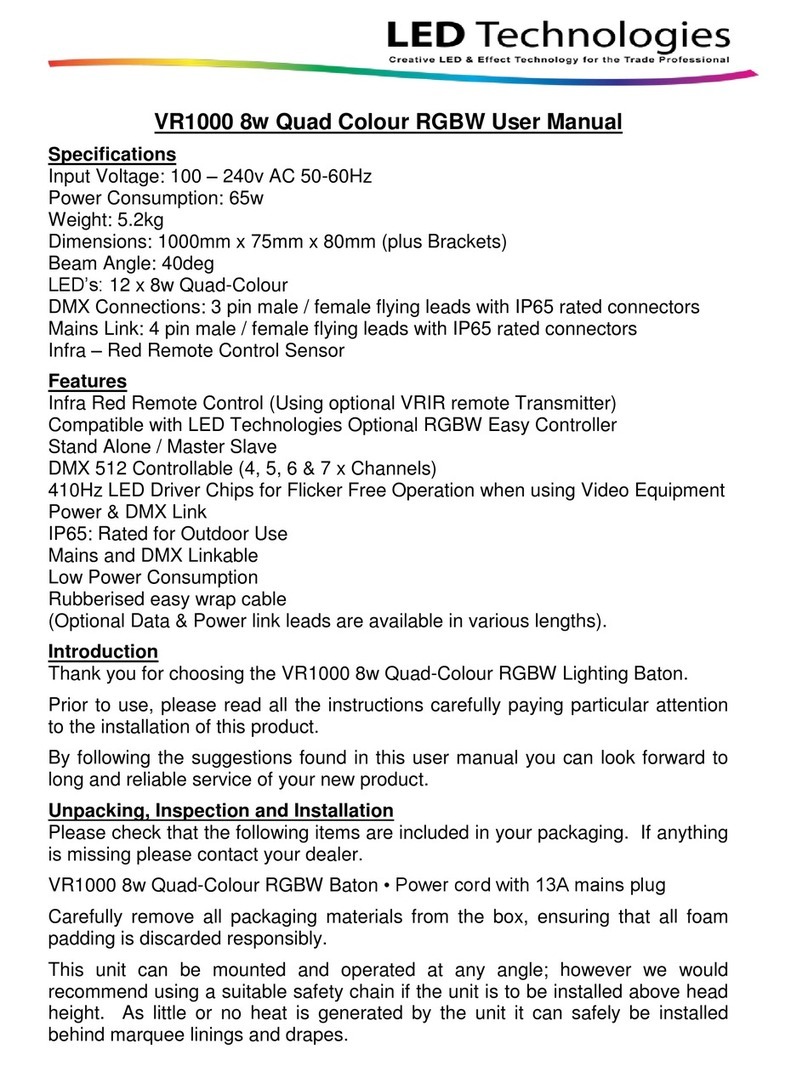
LED Technologies
LED Technologies VR1000 user manual

Luminar Outdoor
Luminar Outdoor 56423 Owner's manual & safety instructions

GTV
GTV CAMINO AE-BPW2FCAM-20 manual
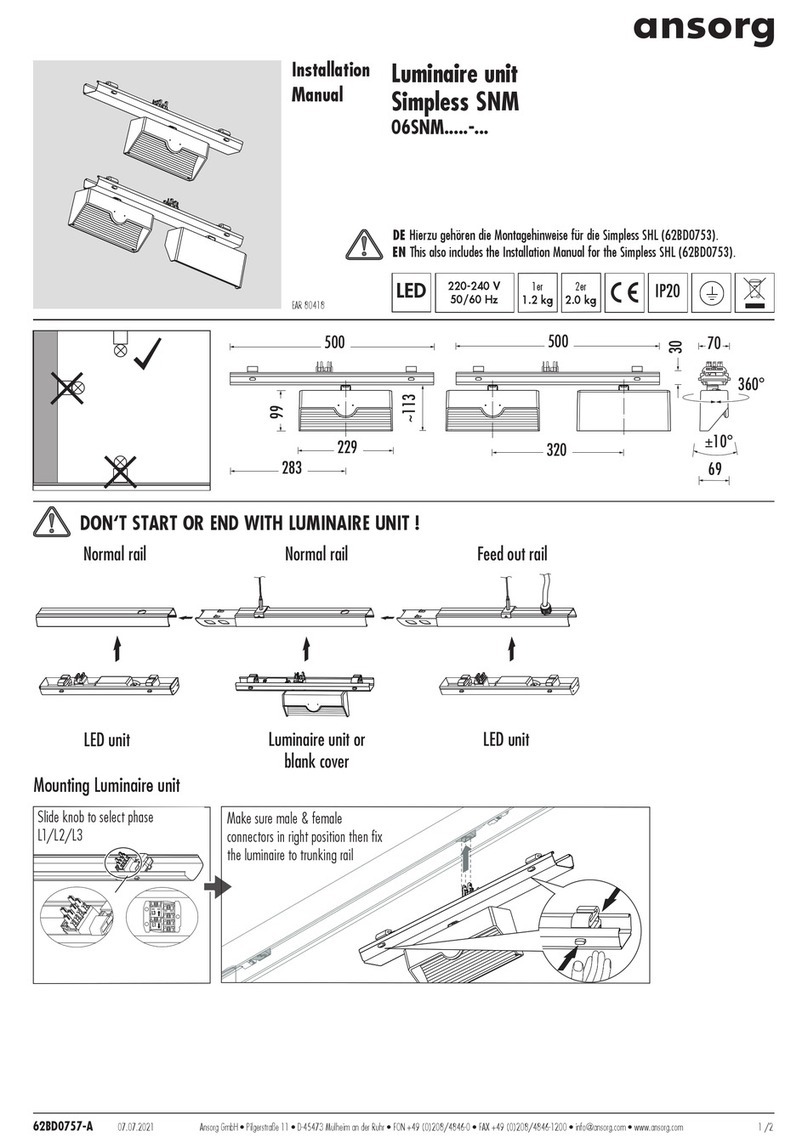
Ansorg
Ansorg Simpless SNM 06SNM Series installation manual

PROEL
PROEL PLLEDMLBG user manual
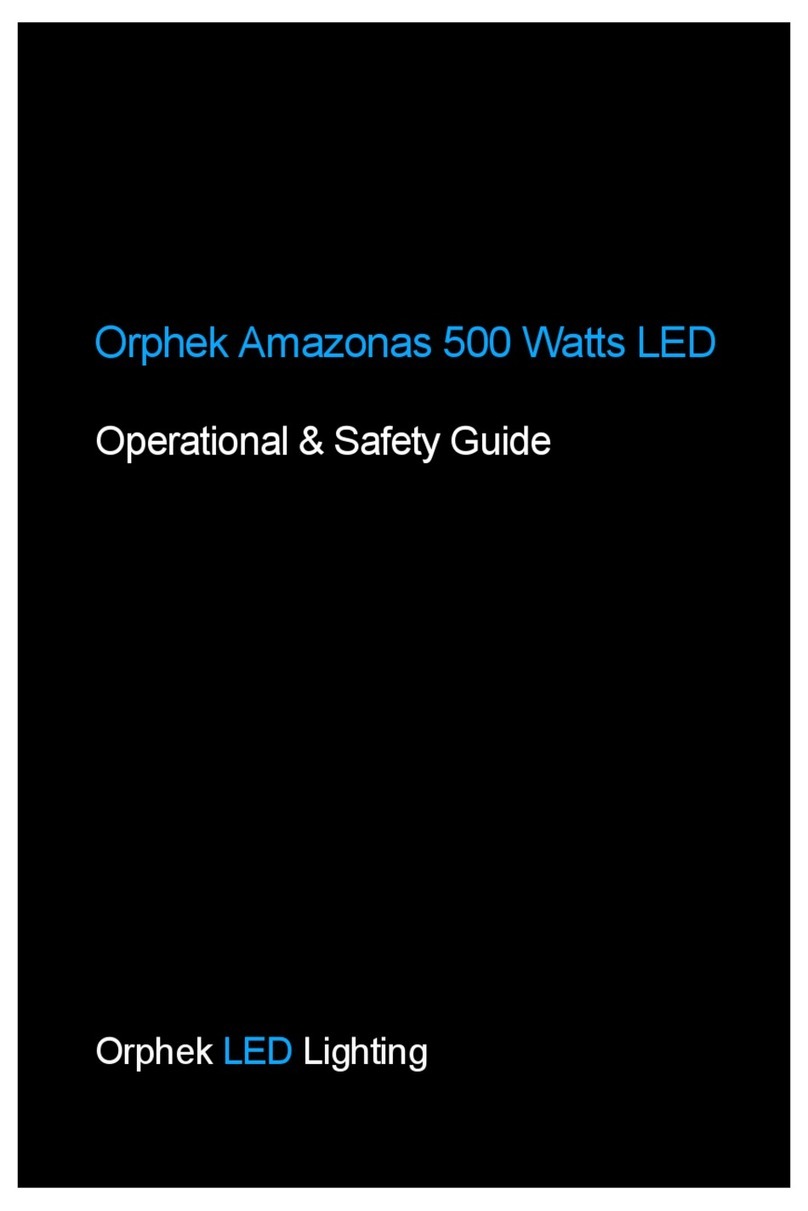
Orphek
Orphek Amazonas 500 Operational & Safety Guide
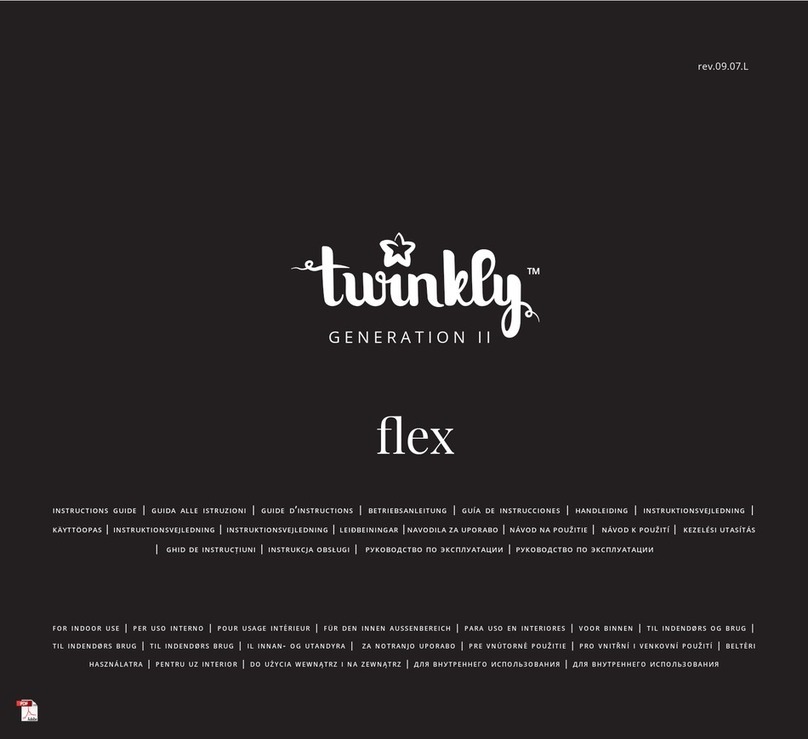
Twinkly
Twinkly TWFL200STW-WEU Instruction guide
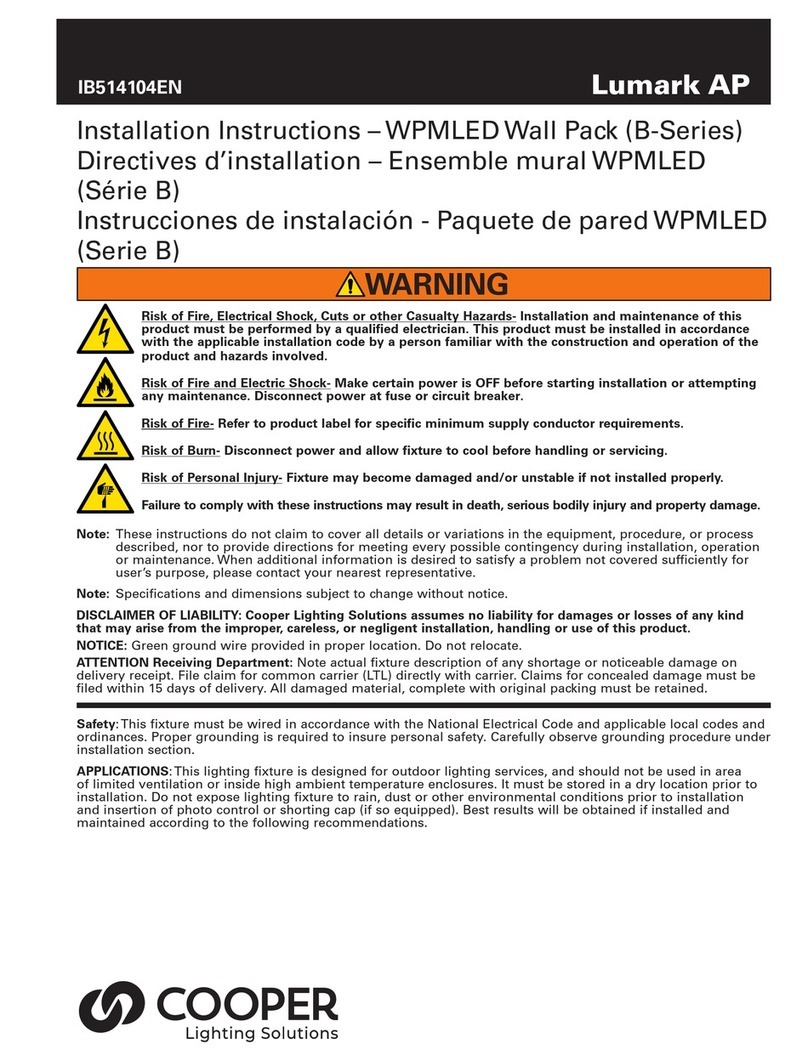
Cooper Lighting Solutions
Cooper Lighting Solutions B Series installation instructions

DAEHAN
DAEHAN STAR L02 user guide
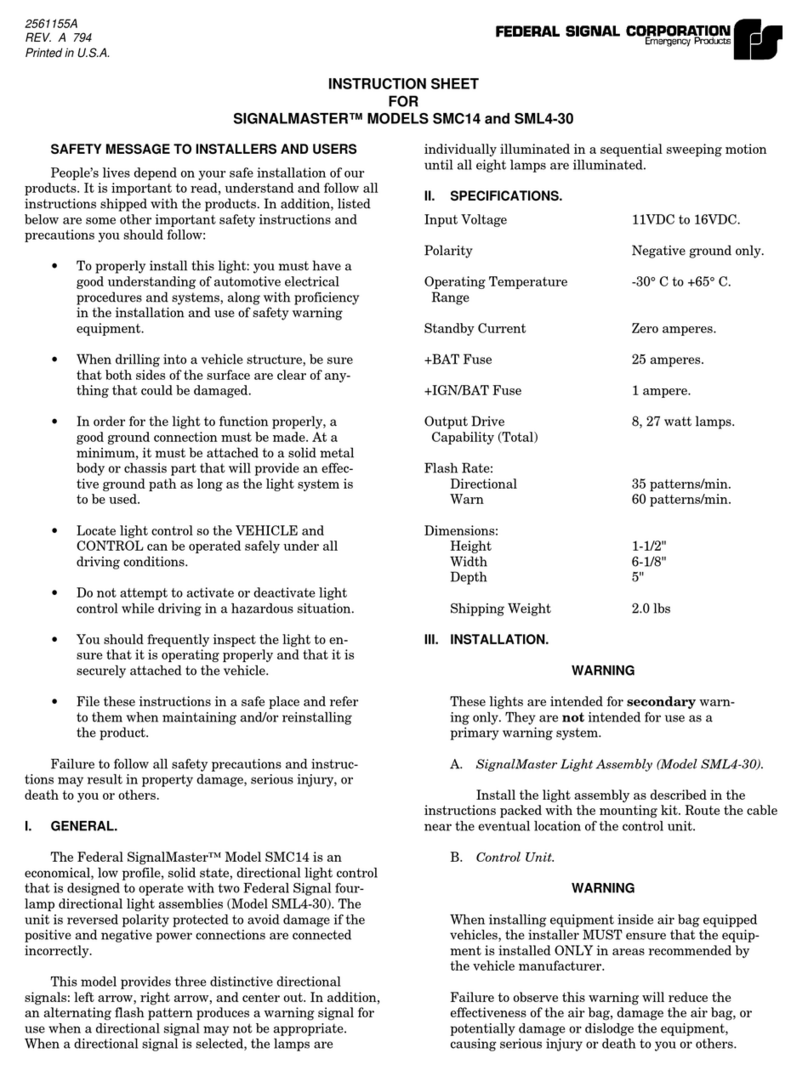
Federal Signal Corporation
Federal Signal Corporation Signalmaster SMC14 instruction sheet
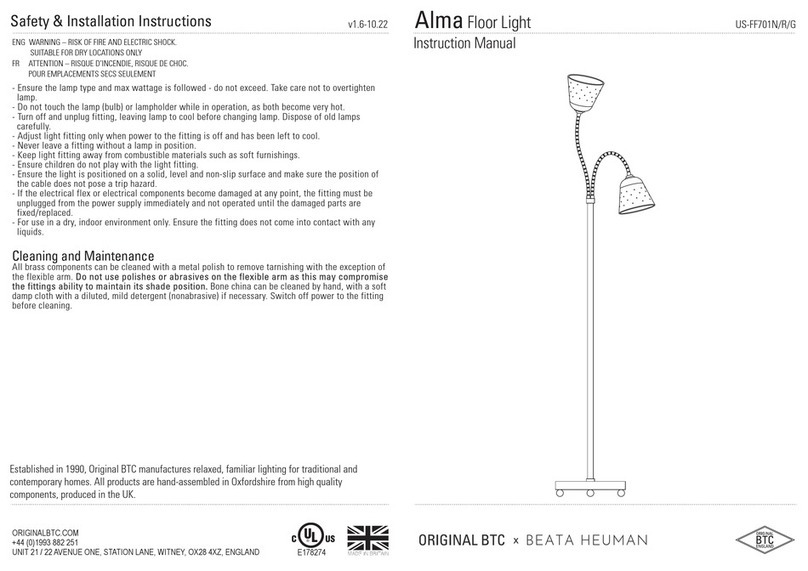
Original BTC
Original BTC Alma US-FF701N instruction manual
